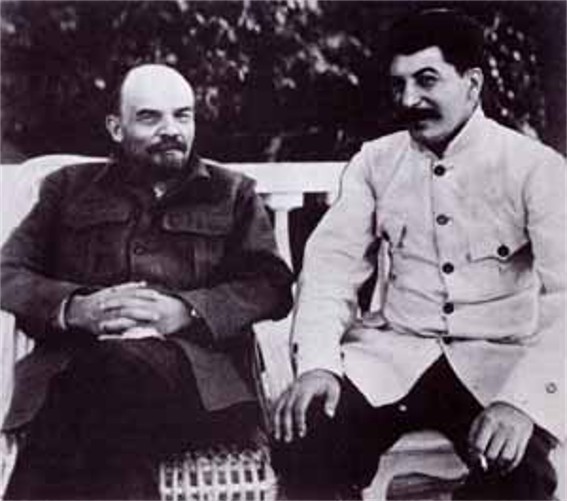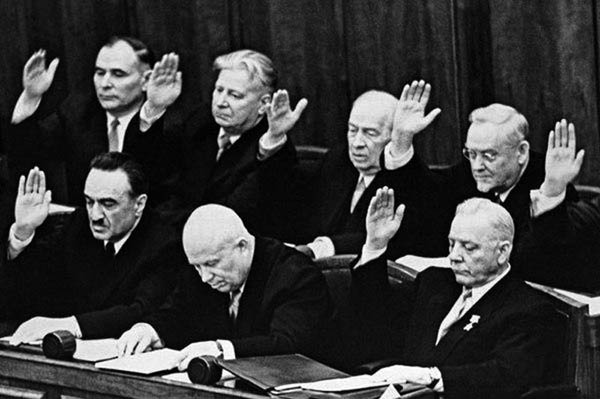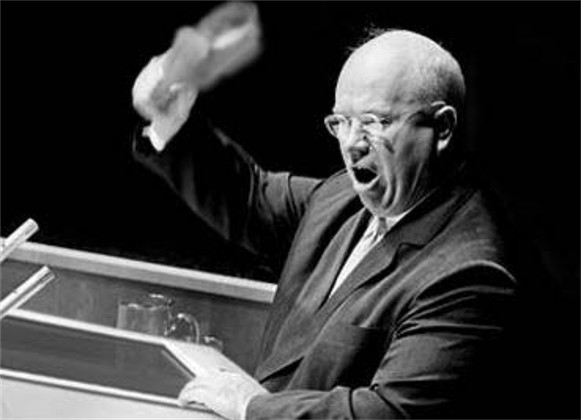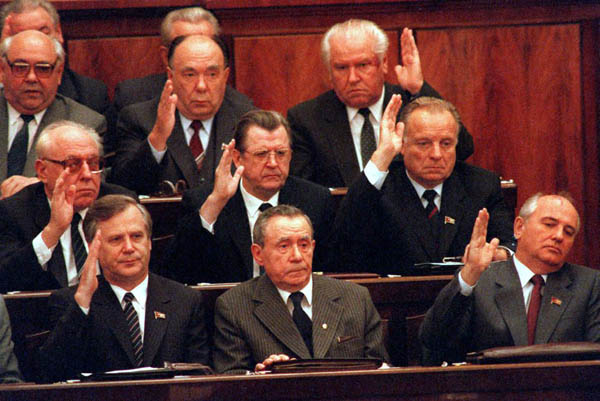Communist Party of the Soviet Union
Communist Party of the Soviet Union or CPSU (Коммунистическая партия Советского Союза; Kommunisticheskaia partiia Sovetskogo Soiuza). Russian totalitarian political organization that held power in Russia from 1917 and in the USSR, including Ukraine (see Communist Party of Ukraine), from 1922 until its dissolution in 1991. Formally, the Party embraced Marxism and Leninism as its ideology.
The CPSU was an offspring of the revolutionary circles of the 19th-century Russian intelligentsia and bourgeoisie, which were supported by the urban proletariat. It arose out of the split in the Russian Social Democratic Workers' party (RSDRP) into Bolsheviks and Mensheviks in 1903. In 1912 it began to shape itself into a separate party under the name Russian Social Democratic Workers' Party (Bolshevik), but it assumed its final form only during the events of the Revolution of 1917. At its sixth congress in July 1917 the Party set itself the goal of taking over the government, and it achieved this with the October Revolution of 1917. At the time the Party had only 115,000 members. Its leaders included Vladimir Lenin, Leon Trotsky, Grigorii Zinovev, Lev Kamenev, Nikolai Bukharin, A. Rykov, and Joseph Stalin. In March 1918 its name was changed to the Russian Communist Party (Bolshevik) or RCP(B).
During 1918–22 the RCP(B) carried out a radical social revolution in Russia and nationalized the property of Russian and foreign capitalists. By fanning and manipulating the revolutionary mood of the peasantry and workers, the Party preserved its dictatorship during the civil war against White Russian forces. Having achieved victory in Russia, the RCP(B) then intervened militarily in the affairs of non-Russian national states that had established themselves during the revolution, including Ukraine, and tried to annex them by force into the Russian Soviet Federated Socialist Republic (RSFSR). In 1918–20 the RCP(B) introduced a form of Communist society and economy known as War Communism, but this effort ended in an economic crisis and revolts against the Soviet government. In March 1921 Vladimir Lenin conceded that this policy was wrong and replaced it with the New Economic Policy (NEP). On the nationality question the Party proclaimed Lenin’s slogan ‘self-determination up to and including separation’ but in practice defended a unitary Russian state. Only in the course of subjugating the national republics that had broken away from Russia in 1917–18 did the RCP(B) recognize the federal form of the Soviet state, in order to get these republics to merge with the RSFSR while preserving a certain autonomy. The idea of merging was opposed by the national republics and their Communist leaders, and in 1922 Lenin agreed to a compromise—the republics were to be preserved, and their national cadres and cultures were to develop within the framework of the Union of Soviet Socialist Republics (USSR).
During 1922–7, that is, during Vladimir Lenin’s illness and after his death, a bitter struggle developed in the Party between the factions of Joseph Stalin and Leon Trotsky. Stalin, who became secretary general of the Party in 1922, took a conservative line, while the Trotskyists demanded a revolutionary line in foreign affairs and rapid industrialization and collectivization at home (‘permanent revolution’). They also demanded democracy and freedom of speech within the Party and criticized Stalin for bureaucratizing the Party and leading the revolution astray. Stalin was supported by the Party apparat, which he had created. Having expelled the Trotskyists from the Party, Stalin adopted part of their program and took a course towards the left. A revolution in Europe seemed out of the question; hence, Stalin decided to build ‘socialism in one country’ by carrying out a rapid industrialization and militarization and then spreading revolution to other countries by force of arms.
Rapid industrialization was accompanied by the elimination of the New Economic Policy and the forced collectivization of agriculture. This was opposed by a faction on the right led by Nikolai Bukharin. The struggle in the Party went on from 1928 to 1930 and ended with Joseph Stalin’s victory. In April 1929 the All-Union Communist Party (Bolshevik) (VKP[B]) adopted the First Five-Year Plan and, in November of that year, a resolution on collectivization. In 1930 Stalin announced that the USSR had entered the period of socialism; in 1934, that socialism had already been established; and in 1937, that a classless society had been achieved in the USSR. Although there was no longer any organized opposition within the Party, in 1934 Stalin began to arrest his former opponents and in 1936–8 unleashed the Yezhov terror against the Party and the people at large. In these years 900,000 members were expelled from the Party and arrested. This was 47 percent of the Party’s total membership in 1935, including 71 percent of the Central Committee membership. All the surviving leaders of the October Revolution of 1917—Grigorii Zinovev, Bukharin, Rykov, and others—were sentenced to death at three show trials in Moscow.
During these purges the composition of the VKP(B) changed drastically. Instead of committed Communists and revolutionaries, as in Vladimir Lenin’s time, the Party members were mostly careerists without political convictions, obedient servants of Joseph Stalin’s dictatorship. The Party magnified the cult of Stalin to the dimensions of idolatry and carried out his slightest whim. The Russians, whose national interests coincided with Stalin’s centralism, constituted the absolute majority in the new bureaucracy. Soon these changes were reflected in the official Party ideology: Communist slogans became muted, and their place was taken by explicit Russian nationalist propaganda. This fact was clearly evident during the German-Soviet war of 1941–5. After the war Russian chauvinism was fostered, particularly by Andrei Zhdanov, and became one of the main instruments of Party policy. The degeneration of Stalin’s regime before his death in 1953 was manifested in such events as secret conspiracies and anti-Semitic campaigns (1949–53). The Party’s foreign policy led to a break with the Communists of Yugoslavia in 1948, the cold war, and the arms race.
After Joseph Stalin’s death the leadership of the CPSU— the name adopted in 1952—consisted of men who had been selected and trained by Stalin, and whose careers had benefitted from the purges. So as to prevent the emergence of another absolute dictator, they formed a ‘collective leadership,’ which lasted only four months. In the summer of 1953 Lavrentii Beria was arrested and later that year was executed. G. Malenkov fell in 1955, followed by Georgii Zhukov, Viacheslav Molotov, Lazar Kaganovich, and others in 1957. In 1956 the 20th Party Congress condemned in moderate terms the cult of Stalin’s personality and the Yezhov terror, but did not touch the major part of Stalin’s legacy. In 1953 Nikita Khrushchev assumed the Party leadership and brought into power new people with no established reputations or political convictions. Stalin’s terror and the totalitarian system did not permit new ideologues or independent leaders to develop within the Party.
Nikita Khrushchev’s failures in foreign policy and internal affairs, mainly in the economic sector, and the disorganization brought about by his separation of local and oblast Party agencies into industrial and agricultural committees, led to his downfall in October 1964. He was replaced by Leonid Brezhnev, who unified the divided CPSU and to some extent applied the principles of so-called collective leadership. The state apparatus was headed by Anatolii Kosygin until 25 October 1980, while Mikhail Suslov, a Russian nationalist and Stalinist, was in charge of ideology, including the nationality question. In 1977, with the change of the USSR constitution, Brezhnev became chairman of the Presidium of the Supreme Soviet of the USSR, that is, the president of the state. Brezhnev succeeded in combining a flexible foreign policy of détente with the growth of Soviet military might, a conservative internal policy, and strict control over the police agencies. Brezhnev died in late 1982 and was succeeded by Yurii Andropov, who assumed all of Brezhnev’s functions, including chairmanship of the Presidium of the Supreme Soviet.
Yaroslav Bilinsky, Vsevolod Holubnychy
[This part of this article originally appeared in the Encyclopedia of Ukraine, vol. 1 (1984).]
No special changes in ideology and political strategy of the CPSU were introduced by Yurii Andropov, except a public relations campaign against indiscipline as a remedy for the stagnation characteristic of the Brezhnev era. Andropov, however, seriously ill throughout his term in office, had to resort to virtual appearances at Politburo meetings. He died of kidney failure in February 1984, at age 69, being succeeded by Leonid Brezhnev’s protégé, Konstantin Chernenko, who in turn survived only 13 months before succumbing to emphysema in March 1985. At that point, the Politburo acted with uncharacteristic boldness by appointing Mikhail Gorbachev as General Secretary. Born in 1931, Gorbachev launched his policies of perestroika, democratization, and glasnost as a cure for the evident decline of the Soviet economy and demoralization of society. He liberalized the economy by allowing private business activity through co-operatives and giving enterprises more autonomy. By opening up Soviet elections to competition—democracy in small doses—as well as by opening up to scrutiny history’s ‘blank pages,’ he began the process of delegitimizing the CPSU’s monopoly as ruling party, rather than the opposite which he had intended. Its constitutionally guaranteed status as the sole ‘leading force of Soviet society’ was officially terminated by the new Congress of People’s Deputies in 1990. Gorbachev’s policies, although popular with the public, generated opposition from conservatives within the Party. The abortive coup against him in August 1991, staged by his own appointees in the government and KGB, served to finally discredit the CPSU. The chief financial officer of the CPSU committed suicide, taking with him the secrets surrounding the Party’s accounts and activities. Following Gorbachev’s resignation as General Secretary, the CPSU was dissolved on 29 August, and finally outlawed on 6 November 1991, 74 years after the Bolshevik October Revolution of 1917.
Initially a party of revolutionaries, the CPSU evolved under its successive leaders into: a vehicle of individual social mobility for careerists and opportunists operating on the basis of patron-clientelism; a parallel government inhibiting initiative and responsibility on the part of Soviet officials; a bureaucracy addicted to routine and drowning in its own paperwork; and generally an inhibitor of intellectual freedom and innovation. Fundamentally, it was always more of a political machine than a party as conventionally understood. In spite of its revolutionary rhetoric, the CPSU came to stand solidly for the status quo in domestic and international politics—seeking stability at home and pragmatically defending the interests of the USSR abroad. It failed not only to deliver the promised communist paradise, but also to adapt to change in the country and the world. Following Joseph Stalin’s prescriptions, it managed to bring into being a kind of ‘barracks socialism,’ an ‘equality of poverty’ from which only the privileged could escape. Its command economy, being artificial, was unsustainable in a globalized world, in spite of decades of reform effort. Its ideology became routinized, its propaganda vapid. People stopped believing in it; they wanted more. Party apparatchiki and others in official posts became businessmen, turning their positions of power into wealth.
Controlling the Party’s affairs and directing the entire country as well was the CPSU’s bureaucracy, the apparat. This was developed by Joseph Stalin on the basis of the CPSU Secretariat. It oversaw and managed all organized activities within the CPSU and throughout the USSR, appointing and dismissing personnel (through the nomenklatura political patronage system), issuing mandatory instructions, and monitoring performance. Rank-and-file Party members were required to be exemplary Soviet subjects: they constituted a pool of potential appointees and served as the leadership’s eyes and ears in all areas of life. Growth of Party membership was supposed to be synonymous with the health of the Party and indicative of its rising influence over society, but was punctuated by occasional purges coinciding with changes of leadership. It dropped precipitously into negative territory during the perestroika of the 1980s. The apparat lost influence when Mikhail Gorbachev decoupled it from managing the government and economy, attempting to transform it into simply a policy-advisor role within the CPSU as a semi-competitive political party.
The Russian Communist Party (Bolshevik), parent of the CPSU, lost its ability to function as a normal political party should, as a channel of expression, when Vladimir Lenin himself brought in a ban on factionalism in 1920. The quintessential Leninist vanguard party would lead the proletariat to its salvation without the need to consult it. Factionalism became punishable by expulsion, exile, or execution—or all three. Disagreements were kept secret. Unity was sacrosanct. Formally, its leaders were elected indirectly from the grassroots; in actuality, power was exercised unchecked from the top down. Almost every leader before Mikhail Gorbachev was removed only by death. The only exception was Nikita Khrushchev. The CPSU was at its dictator-leader’s disposal virtually unchecked except by Politburo colleagues.
Claiming legitimacy on the basis of Marxism-Leninism, the Party was simultaneously the ideology’s custodian and official interpreter. The ideology was the truth, the Party its vessel. No one could be right against the Party. The CPSU could not be held accountable, because it was executing the mandate of history. There was no room here for the rule of law as a standard by which the rulers could be judged or their powers circumscribed. The CPSU legitimated itself.
The program of the CPSU committed the Party to building communism. Already in the 1930s Joseph Stalin had declared the country had attained the preliminary stage of socialism. As the decades went on, communism became an ever-receding goal. In the 1960s, Nikita Khrushchev’s version of the Party program made specific promises to create a New Soviet Man subscribing to the Moral Code of the Builder of Communism, to catch up to and surpass the United States of America economically, and to cross the threshold into communism by the year 1980. Derided as ‘goulash communism,’ his program went into eclipse after his ouster in view of its physical impracticality. Making a virtue of necessity, Leonid Brezhnev issued his doctrine of ‘really existing socialism’ as a rationalization for abandoning efforts to reach the ideology’s ultimate goal and to replace it with complacency.
In effect, the CPSU managed in the course of the 20th century to redefine ‘communism’ into the total opposite of Karl Marx’s vision in the 19th century. Instead of liberation from exploitation it came to mean enslavement, enserfment, and repression. Instead of radical democracy and equality, dictatorship and inequality. Instead of communism, state capitalism. Instead of a dynamic world outlook, whether ‘scientific communism’ or ‘scientific socialism,’ an ossified dogma. As J. P. Plamentaz aptly captured the contrast: it was German Marxism versus Russian Communism. Consequently, communism as a system of government came to mean absolute dictatorship by a self-appointed cabal exercising power, rule, and authority through the Leninist party-state modeled on the CPSU. But the few surviving specimens of such systems in the 21st century are living on borrowed time, being essentially unreformable as the CPSU’s last General Secretary discovered.
Since the 1960s several Ukrainians had positions of influence in the apparat of the Central Committee (CC) of the CPSU: V. Titov, secretary of the CC CPSU and head of the Organization Department of the CC (1962–5); Mykola Pidhirny, secretary of the CC CPSU (1963–5); Petro Shelest, member of the Politburo of the CC CPSU (1964–73); Volodymyr Shcherbytsky, member of the Politburo of the CC CPSU from 1971 until Gorbachev ousted him in 1989; and Volodymyr Ivashko, Deputy General Secretary of the CPSU, and General Secretary for the Party’s final five days after Mikhail Gorbachev’s resignation. In addition, Ukraine served as a springboard in the careers of both Nikita Khrushchev and Leonid Brezhnev. Whether any of this sharing of personnel benefitted the Ukrainian SSR, as opposed to the individual careers of those involved, is questionable.
BIBLIOGRAPHY
Reshetar, J.S. A Concise History of the Communist Party of the Soviet Union, rev edn (New York 1964)
Plamenatz, J. P. German Marxism and Russian Communism (New York 1965)
Rigby, T. H. Communist Party Membership in the U.S.S.R., 1917–1967 (Princeton 1968)
Schapiro, L. The Communist Party of the Soviet Union, rev edn (New York 1971)
Harasymiw, B. ‘The CPSU in Transition from Brezhnev to Gorbachev,’ Canadian Journal of Political Science, 21, no. 2 (June 1988)
Harasymiw, B. ‘Changes in the Party’s Composition: The “Destroyka” of the CPSU,’ Journal of Communist Studies, 7, no. 2 (June 1991)
Rahr, A. ‘The CPSU in the 1980s: Changes in the Party Apparatus,’ Journal of Communist Studies, 7, no. 2 (June 1991)
Jowitt, K. New World Disorder: The Leninist Extinction (Berkeley 1993)
Harasymiw, B. Soviet Communist Party Officials: A Study in Organizational Roles and Change (Commack, NY 1996)
Solnick, S. Stealing the State: Control and Collapse in Soviet Institutions (Cambridge, Mass., and London 1998)
Bohdan Harasymiw
[This part of the article was written in 2020.]

 14th Conference (1925).jpg)



